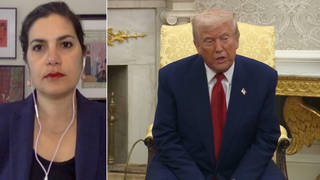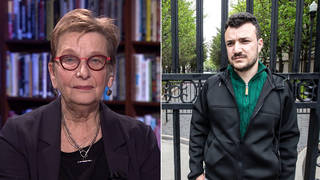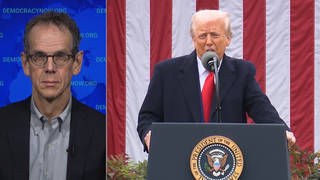
US authorities have said fifteen-year-old Sergio Adrian Hernandez Güereca was part of a group of boys throwing rocks at Border Patrol agents who were trying to detain two people at the border crossing. But a cell-phone video obtained by the Spanish language network Univision shows otherwise. The grainy footage shows the Border Patrol agent detaining one man at gunpoint. While he has the man on the ground, he points his gun toward a second person on the Mexican side of the border. The video shows that person running away as the agent fires several shots. The video then shows a body next to a column under the bridge. We speak to Fernando Garcia, the director of the Border Network for Human Rights. [includes rush transcript]
Transcript
JUAN GONZALEZ: New evidence has emerged that casts doubt on the claims of a US Border Patrol agent who shot and killed a fifteen-year-old Mexican boy on Mexican soil on Monday. The teenager, Sergio Adrian Hernandez Güereca, was shot in the head on the banks of the Rio Grande that divides the United States and Mexico.
US authorities said Hernandez was part of a group of boys throwing rocks at Border Patrol agents who were trying to detain two people at the border crossing. But a cell-phone video obtained by the Spanish-language network Univision shows otherwise. The grainy footage shows a Border Patrol agent detaining one man at gunpoint. While he has the man on the ground, he points his gun towards a second person on the Mexican side of the border. The video shows that person running away as the agent fires several shots. The video then shows a body next to a column under the bridge. Witnesses also dispute the claims of the Border Patrol agent. They say Hernandez was hiding behind the column when he looked out and was shot in the head.
WITNESS: [translated] Nothing. They were not carrying anything. They weren’t carrying weapons, packages, backpacks. Only the clothes they were wearing. That’s it. The teenager lying there, the only thing that he did was look out. When he looked out, he was shot. The agent shot him twice. He thought about it for about five seconds, because he shot at him once, left him astonished, then he shot him again. It seems he was hit in the head.
JUAN GONZALEZ: The family of fifteen-year-old Sergio Adrian Hernandez Güereca held a vigil for him at their home on Tuesday night. His mother, Maria Güereca, said the US Border Patrol agent destroyed her son’s dreams.
MARIA GÜERECA: [translated] I ask only one question: don’t they have children? Hopefully not, because the same thing could happen to them, to end a life that should have been ended like that. My son had many hopes, many dreams to move ahead. He used to tell, “Mama, I want to study. I want to be a police. I want to be a soldier.” They didn’t let him realize his dreams. They killed him. Along with him, they took my life away, because he was everything for me.
AMY GOODMAN: The killing of Sergio Hernandez has sparked an uproar with protests and vigils on Wednesday on both sides of the border. In Ciudad Juárez and El Paso, Mexican government officials, from Juárez Mayor José Reyes Ferriz to the President, Felipe Calderón, have condemned the shooting. And Amnesty International released a statement saying, quote, “This shooting across the border appears to have been a grossly disproportionate response and flies in the face of international standards that compel police to use firearms only as a last resort,” unquote. The shooting comes just weeks after President Obama announced a plan to send an extra $500 million and 1,200 National Guard troops to the border.
Two weeks ago, a Border Patrol officer in California shot and killed an undocumented Mexican immigrant with a stun gun. The thirty-two-year-old Anastasio Hernández had lived in San Diego since he was fourteen and had five American-born children. Border Patrol agents claim he had resisted being deported.
For more, we go to El Paso, Texas, where we’re joined on the telephone by Fernando Garcia, the director of the Border Network for Human Rights.
Welcome to Democracy Now!, Fernando. Can you tell us the latest, what you understand happened on the border with Sergio?
FERNANDO GARCIA: Yeah. Good morning, Amy.
Yes, yes, actually, there are more details now. Obviously there’s a video that actually confirm our worries and our concerns. We clearly believe that Sergio Adrian Hernandez did not represent an imminent threat to the life of the agent, or for anybody, actually, and that the use of lethal force in this case was unjustified. I mean, this was a kid already clean into Mexico, and he ended up being shot and killed by a Border Patrol agent. So, right now there’s a mixed feeling right now in border communities of fear and anger, but also at the same time they want some solutions and some justice.
JUAN GONZALEZ: And Fernando, in terms of the response in Mexico by President Felipe Calderón and other officials there, how has this been treated there on the other side of the border?
FERNANDO GARCIA: Well, we see it. I mean, we see that there is a response, that also the Mexican consulate, they are working hard with the family to actually bring some of the details up to the discussion. But I think it’s important for us to keep pushing for a prompt and a transparent investigation. I mean, this is — one of the things that we need to understand is that this is not an isolated incident. In just this year, from January to up today, we have seventeen incidents where immigrants, mostly Mexicans, have been injured and killed by the actions of Border Patrol agents.
AMY GOODMAN: Can you tell us more about the father of five, US children, who lived in San Diego for years, who was killed by a Border Patrol guard wielding a stun gun as he, they said, resisted being deported?
FERNANDO GARCIA: Well, that’s also a troubling case, where you have an individual that is under control already, that is ready to be deported, that probably was resistant, possibly was resisting — there’s not much evidence for that — and he was surrounded by almost twenty agents from at least three different agencies — Border Patrol, CBP and ICE. And he was already on the floor, and they were beating him. They were just — they used at least two times the tasers. And there’s a video also where he is calling for help, and nobody is helping. And the agents continue to actually exercise brutal force against this immigrant. So, again, I mean, we are really, really concerned about what are the protocols and the guidelines of these agents to use lethal force against unarmed civilians, and especially immigrants.
JUAN GONZALEZ: Fernando, one of the things that apparently have come up is that federal officials are suggesting that the teenager who was killed was actually a coyote, one of the people who helps transport people across the border. What have you learned from your interviews of witnesses on the scene there in El Paso?
FERNANDO GARCIA: Well, we have talked to family, and also we have talked to witnesses. And also, there’s a couple of articles and some information being released about the fourteen-year-old teenager being a smuggler. But at the end, I mean, we do not understand how this makes a difference or not. I mean, whether he was or not, I mean, that didn’t justify killing him. I mean, the agents are — cannot be the judges, the prosecutors, and they cannot kill somebody because they think or because they later on realize that he was a smuggler. I think that is — that only is trying to justify the fact that a fourteen-year-old boy was killed by irrational force in Juárez.
AMY GOODMAN: What about President Obama announcing the sending of 1,200 more National Guard to the border and 500 more million dollars?
FERNANDO GARCIA: Well, that’s the solution that we didn’t expect. I mean, when President Obama took office, he promised comprehensive immigration reform. He promised sensible solutions and humane solutions. And look at what we’ve had so far: more deportations — possibly more deportations than the last year of the Bush administration. We have now people being killed at the border. We have soldiers being sent to the border. And no comprehensive immigration reform. I mean, people at the border, but also I believe in the nation, are a little bit disappointed about how the administration actually has not resolved this issue of immigration.
AMY GOODMAN: And the FBI?
FERNANDO GARCIA: Excuse me?
AMY GOODMAN: The FBI? Your assessment of how the FBI is dealing on the border?
FERNANDO GARCIA: Well, at least in this specific case, the FBI, in my opinion, is not being really professional, because — this is very frustrating, because this Monday, when the incident happened, there was a release by the FBI pretty much justifying the incident, saying that the agents were attacked or that the agent was attacked by migrants and that the agent actually defended himself. And we didn’t think that that was the responsibility of the FBI. I mean, the FBI should have conducted a prompt, a transparent and clear investigation before actually judging the case, and I think that didn’t happen. I think what we are asking is for the FBI to clean this investigation and to talk to witnesses, to see the videos, and then express a judgment on that.
JUAN GONZALEZ: Fernando, I want to ask you about the general situation there in El Paso. You are across the border from the largest city on the Mexican border, Juárez, which has become really the center now not only — especially of violence related to drug trafficking and increasing problems there at the border. But very little attention is being paid to how many people in Mexico really have been forced off the land and to flee to the United States as a result of the losses to agriculture resulting from NAFTA. Could you talk about what the general situation is in Juárez today and how that’s affecting life in El Paso, as well?
FERNANDO GARCIA: Well, yes, what we see in Juárez is a decomposition of the social structure. I think we have several problems in Juárez. We have the violence. We have the inability of the police to actually contain the violence in Juárez. At the same time, we have a very deep economic crisis where people are being pushed out of the country.
But let me make this fact clear, though, I mean, because sometimes there’s this information that actually portrayed the border, especially the border cities of El Paso or San Diego, as violent cities also or that the border is out of control and that it’s unsafe. El Paso is the second safest city of its size in the nation. And actually, we just had one murder in the last year — in this year. The second one is this one that happened with Sergio Adrian Hernandez. So, our border cities on the US side are quite safe. I mean, there is no such disorder. There is no such chaos and out of control as that sometimes has been presented by political reasons. And we are very concerned, because at the end, I mean, what you hear and you listen in Washington or in Chicago is that the border is out of control, and that is not the case.
And I guess we do have a problem in Juárez. We do have a problem in Mexico. I mean, there’s, as I say, a decomposition of the social structure in Mexico, not only in Juárez. But the United States has the responsibility to help to alleviate that problem economically, but also in terms of security.
AMY GOODMAN: Finally, Fernando, this latest news from congressional sources briefed in the matter last week: US Customs and Border Protection began flying unmanned surveillance missions along the Mexican border. The first Texas-bound drone flight traveled from Arizona to New Mexico to near El Paso. What do you know about this?
FERNANDO GARCIA: No, it is happening, and it is part of the trend of what we consider increasing militarization of the border. I mean, it’s not only 20,000 Border Patrol agents or the National Guard, but also it comes with a lot of technological infrastructure. I mean, the drones or sensors or — I mean, that is happening. And sometimes we actually question how effective those are, how expensive this is, especially now in a situation where we have this crisis, and how much money we have wasted in things such as the border wall and now with the drones. I think it is important for Congress and for the administration to actually review what is happening.
AMY GOODMAN: Fernando Garcia, we want to thank you very much for being with us, director of the Border Network for Human Rights, speaking to us from El Paso, Texas.












Media Options